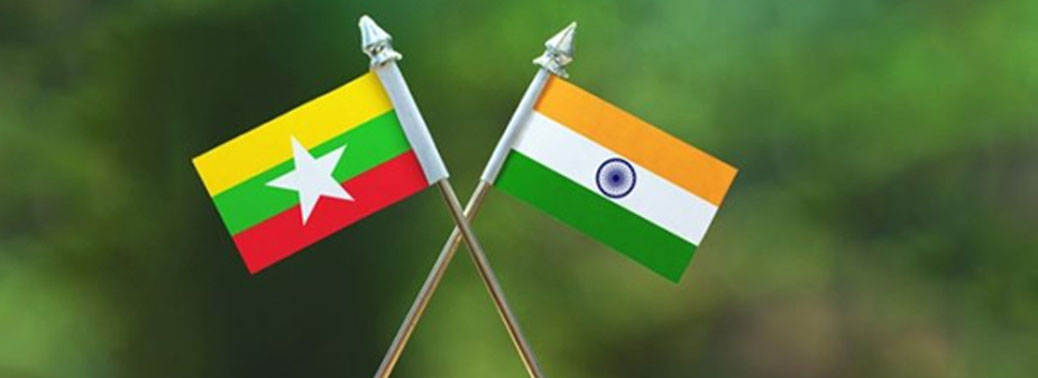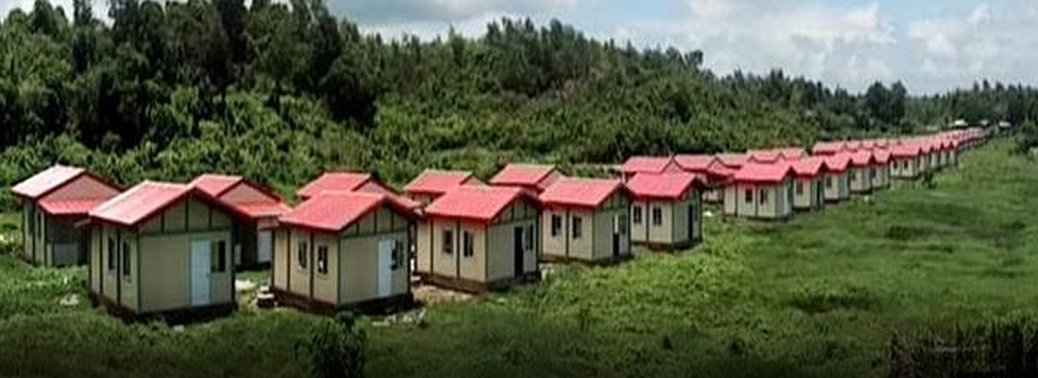Category: India and Myanmar
INDIA – MYANMAR TIES
28, Feb 2020

Context:
- Recently, India and Myanmar exchanged 10 agreements in fields ranging from infrastructure, energy, communication and health. The agreements and Memorandums of Understanding (MoUs) were signed and exchanged after talks between Prime Minister Narendra Modi and Myanmar President U Win Myint.
Key Facts:
- The focus of many agreements was on development projects under India’s assistance, particularly in the conflict-torn Rakhine state.
- The agreements included an MoU on ‘Cooperation for Prevention of Trafficking in Persons; Rescue, Recovery, Repatriation and Reintegration of Victims of Trafficking’.
- An agreement regarding Indian Grant Assistance for Implementation of Quick Impact Projects (QIP) under Mekong-Ganga Cooperation mechanism was also signed between the two sides.
- India will carry out more development projects in the Rakhine province of Myanmar, which is considered the homeland of the Rohingya community.
India – Myanmar
- India shares a land border of over 1600 kms with Myanmar as well as a maritime boundary in the Bay of Bengal.
- Four north-eastern states, viz., Arunachal Pradesh, Nagaland, Manipur and Mizoram, have a boundary with Myanmar.
- Both countries share a heritage of religious, linguistic and ethnic ties.
- Myanmar is the only ASEAN country adjoining India and, therefore, a gateway to SouthEast Asia.
- Myanmar is the only country that sits at the intersection of India’s “Neighborhood First” policy and “Act East” policy.
- India is the fifth largest trading partner of Myanmar and the current bilateral trade stands at US $ 1.7 billion.
Trade and Economy
- A bilateral Trade Agreement was signed in 1970. Bilateral trade has been growing steadily.
- India is the fifth largest trading partner of Myanmar and the current bilateral trade stands at US $ 1.7 billion.
- Agriculture sector dominates the trade, particularly the supply of beans & pulses to India and timber.
- India’s major exports to Myanmar include sugar, pharmaceuticals.
- India is presently the eleventh largest investor in Myanmar.
- Most of India’s investments have been in the oil & natural gas sector.
Transport
- Myanmar is potentially an important partner in the energy sector as future offshore gas finds can be piped to India.
- India is building the Kaladan Multi-Modal Transit Transport, to link Kolkata to Sittwe in Myanmar and then from Myanmar’s Kaladan river to India’s north-east.
- India, Myanmar, and Thailand are building the Asian Trilateral Highway, which will connect India to ASEAN.
- As part of its policy for the Indian Ocean called Security and Growth for All in the Region (SAGAR), central to which is “port-led development,” India developed the Sittwe port in Myanmar’s Rakhine state
Development Cooperation
- India has extended around $2 billion as soft loans.
- India is extending assistance for border area development in Chin State and the Naga Self-Administered Zone by financing infrastructure.
- India is also providing assistance in setting up institutions for higher learning and research, namely Myanmar Institute of Information Technology, Advanced Centre for Agricultural Research and Education, etc.
- India helped in the setting up of infrastructure and socio-economic projects jointly with Myanmar in the Rakhine state to upgrade the livelihood of the people.
Defence Cooperation
- India-Myanmar Bilateral Army Exercise (IMBAX) is aimed at building and promoting closer relations with armies.
- Myanmar is a key partner in the fight to end insurgency in India’s northeast.
Culture
- India and Myanmar share cultural ties in terms of Buddhist heritage and shared history of colonialism.
- Building on this shared heritage, India is undertaking some key initiatives in the restoration of the Ananda Temple in Bagan and the repair and conservation of a large number of damaged pagodas.
Disaster Relief
- India has responded promptly and effectively in rendering assistance following natural calamities in Myanmar like Cyclone Mora (2017), Komen (2015), earthquake in Shan State (2010).
- India also offered to provide support in capacity building in disaster risk mitigation as well as in strengthening Myanmar’s National Disaster Response Mechanism.
Indian Diaspora
- There are varying estimates of 1.5-2 million people of Indian origin living and working in various parts of Myanmar, since the times of colonial British rule.
Multilateral Partnership
- Myanmar is also a key component of India’s strategy to bridge South and South-East Asia through BIMSTEC.
- Myanmar’s membership of ASEAN, BIMSTEC and Mekong Ganga Cooperation has introduced a regional/sub-regional dimension to bilateral relations.
- Myanmar has been added to SAARC as an observer, which it formally acquired in 2008.
The Chinese Mileage:
- China has been instrumental in shielding Myanmar from international sanctions at the United Nations, in the Rohingya issue.
- China is also Myanmar’s biggest trading partner and one of its largest sources of inward investment. China is making its presence in Myanmar through the construction of the Kyaukpyu port, as a part of its Belt and Road Initiative.
- China’s increased presence in Myanmar could mean constraints on India that wishes to deepen cooperation with Myanmar.
- With Myanmar seemingly drawing closer to China under pressure from the West, Beijing could attempt to keep the country under its influence like it does in the case of Cambodia and Laos.
- Chinese influence in the region might result in a huge setback for India whose investment in Myanmar is comparatively less.
Way Forward:
- Because of geopolitical considerations, India will need to perform a balancing act between Muslim-majority Bangladesh and Buddhist-majority Myanmar as far as the Rohingya issue is concerned.
- The quicker the Rohingya issue is resolved, the easier it will be for India to manage its relations with Myanmar and Bangladesh, focusing instead more on bilateral and subregional economic cooperation.
- Myanmar is an emerging consumer market of 60 million people who have demands for products ranging from personal care to beverages to smart phones. India should leverage these export opportunities.
- “Pauk Phaw”, which literally means ‘born together’, a historical relation between China and Myanmar, is a case for concern for India.
INDIA BUILDS 250 HOMES IN MYANMAR TO ASSIST ROHINGYA
15, Jul 2019

Why in News?
- Two years after more than 700,000 Rohingya fled to camps in Bangladesh alleging ethnic cleansing by Myanmar forces, the Indian government says it is stepping up efforts to help them return to their villages.
- Recently, India’s Ambassador to Myanmar, Saurabh Kumar handed over 250 completed pre-fabricated homes to the Myanmar government for use by the refugees when they return.
Part of 2017 pact:
- The project is part of an agreement signed by the two governments in 2017, under which the government had committed to spending $25 million over five years.
- The houses, measuring 40 square metres each, are designed to survive quakes and cyclonic storms. The 250 houses, built in three clusters, are in the Shwe Zar, Kyein Chaung Taung and Nan Thar Taung areas that saw some of the worst cases of violence, including mass murder, gang-rape of women and children and burning of thousands of homes.
- They have cost about ₹10 crore.
- However, there are no signs yet that the Rohingya will return at any specific date.
A Look at other developments:
- The Myanmar government has also handed over a list of 21 other projects that it wants India to fund as part of the agreement, including the construction of small villages, culverts and school buildings. It is important to note that hundreds of thousands of Rohingya, mostly Muslim, fled the violence that started after a local militant group ARSA attacked several Myanmar police posts in August 2017, killing about 12, and also Hindus in nearby Rakhine villages. In attacks on the Muslim Rohingya, termed ‘retaliatory’ by Myanmar’s Junta and the majority Buddhist community, thousands were killed. Nearly a million Rohingya, including about 400 Hindu families, are now living in precarious conditions.
International Concern:
- The government in NayPyiTaw still refuses to recognise the Rohingya as citizens and will not prosecute military personnel and civilians for the killings, which the United Nations officials said bore the hallmarks of genocide.
- In such a situation, several international refugee relief and human rights agencies have counselled against forcing the refugees to return to Myanmar.
- Making the situation worse are monsoon rains and flooding at the camps in Bangladesh that have already affected about 45,000 people since April 2019, even as international funding for the camps dwindles.
- Despite the desperate situation for them, there are no signs yet that the Rohingya refugees will return at any specific date, and officials could not confirm when they would actually occupy the houses being built by India and also by Japan, China and ASEAN countries for them.
MORAL AMBIGUITY ON THE ROHINGYA
21, May 2019

Why in News:
- India must break its silence on the gross human rights violations by Myanmar
Details:
- India’s abstention from voting on a UN Human Rights Council draft resolution, on the “situation of human rights in Myanmar” needs closer examination.
- Co-sponsored by the European Union (EU) and Bangladesh, the resolution “expresses grave concern at continuing reports of serious human rights violations and abuses in Myanmar”, particularly in Rakhine, Kachin and Shan States, and calls for a full inquiry into these by the Council’s own mechanism and the International Criminal Court (ICC)
- What is deeply unfortunate is India’s continued diplomatic and moral passivity on the
Rohingya crisis. - Despite the Myanmar Army facing charges of serious war crimes, including genocide — according to a UN Fact-Finding Mission (FFM) and several other international human rights organisations — India refuses to take a strong moral stand for the sake of maintaining cordial bilateral relations with Naypyidaw.
- There was no reference by India to the excessive and arbitrary force used by security forces on Rohingya civilians in response to the “extremist violence”.
- India is one of Myanmar’s top arms suppliers, and weapons sales includes military aircraft, artillery, naval vessels and reconnaissance equipment, armoured vehicles, anti-submarine torpedoes and missiles. Whether Myanmar is using some of its India-supplied weapons to maim non-combatant civilians in Rakhine State and other ethnic regions is a question that New Delhi has not asked so far.
Through Dhaka’s lens
- India has so far refused to exert any pressure on Myanmar, instead choosing to balance ties with Dhaka and Naypyidaw by sending humanitarian aid to both. But India’s soft, backfoot approach is being increasingly seen by Bangladesh, which is hosting nearly a million Rohingya refugees, to be tilted in Myanmar’s favour.
- It is clear that if India continues to tacitly favour Myanmar at international forums, its much- valued bilateral ties with Bangladesh may suffer greatly.
- India has deported (or refouled) more than a dozen Rohingya refugees from its own territory back to Myanmar, in violation of international and domestic legal norms.
- Using the geo-economic leverage that it enjoys with Myanmar, India could compel Myanmar to bring the alleged perpetrators of war crimes to book or at least get a guarantee that such conduct would not be repeated in the future
- For now, India is happy to be in a stable, but morally tenuous, friends-with-benefit relationship with Myanmar. The victims continue to be the stateless Rohingya.
United Nations Human Rights Council (UNHRC)
- It is an inter-governmental body within the United Nations system
- It is responsible for promotion and protection of human rights around the globe and for addressing situations of human rights violations and make recommendations on them.
- It was created by UNGA on 15 March 2006 by adopting resolution 60/251 to promote human rights globally.
- It had replaced former UN Commission on Human Rights. It is headquartered in Geneva, Switzerland.
INDIA, AUSTRALIA TO ADOPT CLASSIFIED COMMUNICATIONS
12, May 2019

Why in News:
-
Australian Navy is, at present, “hanging off” COMCASA — India’s secure communications
agreement with the U.S. — Australia
Background:
- India moving to classified communications environment that one would see, for instance, in the Combined Task Force 150, 151 and 152 operations, where there’s a bunch of like- minded countries that have a communications system that is operating at the classified level, to be able to allow them to talk together.
Relation between India and Australia:
- The establishment of India-Australia Joint Ministerial Commission (JMC) in 1989 encouraged dialogue at a government and business level on multiple issues of trade and investment.
- India-Australia CEO Forum is a significant mechanism through which business leaders from both nations engage in mutually fruitful dialogue to enhance bilateral trade and investment relationship. The Forum consists of heads of Indian and Australian business from multiple sectors like energy and resources, agri-business, financial sector, telecommunications, IT, education and pharmaceuticals. The last meeting of the Forum was held in New Delhi on 29th August 2017.
- The city of Canberra, Australia hosted the seventh India-Australia Economic Policy Dialogue during 16-18 July 2017.
- India s main exports to Australia are passenger motor vehicle and machinery, pearls, gems and jewellery, medicaments (including veterinary) and refined petroleum products.
- India s major imports from Australia are coal, non-monetary gold, copper, wool, fertilizers, wheat, vegetables and education-related services.
- In 2016, India s trade in goods and services with Australia was about US$ 15.6 billion. In 2016, India s export to Australia was about US$4.6 billion.
- In 2016, India s import from Australia was about US$11 billion.
- The two countries are also involved in the RCEP (Regional Comprehensive Economic Partnership) negotiations.
- Indian companies have invested in Australian mining sector successfully.
- India is the fifth largest export market for Australia and tenth largest trading partner overall.






